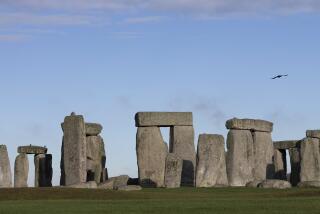Stonehenge may have been ancient Lourdes
British researchers think they have solved the decades-old mystery of why ancient Britons transported massive rocks 250 miles from Wales to Salisbury Plain to construct the massive but enigmatic Stonehenge monument: They believed the stones possessed healing powers.
A variety of archaeological evidence, including results from the first excavation inside the monument in nearly half a century, also suggest that the first stones were placed at least 200 years later than previously believed and that the Romans may have altered the stones during their occupation of Britain.
The findings do not conflict with other recent theories about the uses of Stonehenge -- which indicate that it was an astronomical observatory, a cemetery and the site of biannual celebrations that honored the dead and the living. But they do suggest that the monument also was an ancient Lourdes where pilgrims congregated to have their wounds and illnesses magically healed.
Stonehenge has “multiple meanings and multiple uses” that may have changed over the centuries, said archaeologist Mary Ann Owoc of Mercyhurst College in Erie, Pa., who was not involved in the new research. “To limit it to one is an error.”
The idea that the stones are not just building materials but have efficacy “is tremendously appealing as an idea,” said archaeologist Julian Thomas of Manchester University, who also was not involved in the research. “The idea that they were brought there because they have some kind of power seems to me entirely plausible. But whether it is just about healing is another question.”
The new findings were reported in the current issue of Smithsonian magazine and at a news conference today in London.
The monument comprises concentric circles of massive stones, some weighing as much as 50 tons, surrounded by a circular earthen bank and ditch. The largest stones, called sarsens, were quarried about 24 miles north of Stonehenge at Marlborough Downs. The smaller ones, called bluestones because they take on a bluish cast when wet or cut, were imported from Wales at great effort and expense.
Bluestones are thought to possess healing powers, according to medieval literature and folklore, but researchers have assumed that this was a recent association unrelated to the monument’s initial purpose.
But archaeologists Timothy Darvill of Bournemouth University and Geoffrey Wainwright, president of the Society of Antiquaries of London, speculated that the tradition had its origin much earlier.
To investigate, they first surveyed the Preseli Mountains in South West Wales, site of the quarry known as Carn Menyn and the source of the bluestones. They found that many springs around the quarry had been dammed to create “enhanced springheads,” or pools of water that the sick could bathe in.
That idea was supported by prehistoric art and burial cairns associated with the pools, created by the same early Britons who built Stonehenge. When they saw the artifacts, Wainwright recalled, “Tim and I looked at each other and said, ‘It’s got to be about healing.’ ”
Last April, the team removed an 11-foot-long trench on the inner circle of the bluestones at Stonehenge, the first excavation there since 1964. The site is such a prized cultural monument that permission for the work had to be obtained from the British Cabinet.
And for the first time, small fragments of carbonized plant material were isolated for use in determining the age of the bluestones.
Fragments from the bottom of the trench indicated that activities were occurring at the site from 7330 to 7070 BC, much earlier than had previously been suspected.
Carbon fragments at the base of the bluestones indicated that they had been set into the soil sometime between 2400 and 2200 BC, two to four centuries later than the previous date of 2600 BC.
“That fits rather nicely with the spread of Beaker culture pottery across Europe,” which was associated with large-scale population migrations, Darvill said.
That date also correlates with the grave of the so-called Amesbury Archer, an adult male excavated nearby with a healed head wound and a damaged left leg. Darvill and Wainwright speculate that he and other injured people buried in the area came there seeking the healing powers of the stones.
More recent layers of the strata showed fragments that were chipped off the bluestones and at least two Roman coins from well below the surface.
Clearly, Darvill said, populations have been chipping away at the bluestones for long periods of time and taking them away as talismans and lucky charms, indicating that the stones’ reputation for healing powers extends well before medieval times.
The pair’s next step will be to go back to Wales and excavate one of the burial cairns found there, Darvill said.
“We would like to find the old land surface and traces of the exploitation of the stones,” he said.
--
More to Read
Sign up for Essential California
The most important California stories and recommendations in your inbox every morning.
You may occasionally receive promotional content from the Los Angeles Times.










